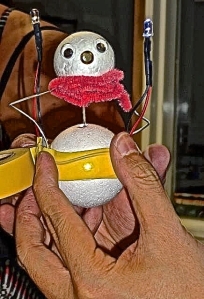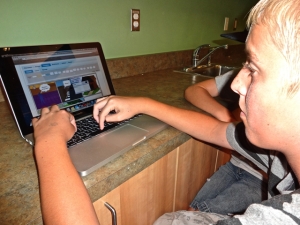Cross Curricular Maker Education Activity That Addresses Common Core Standards
My primary job is that of educating pre and in-service teachers with a bit of teaching elementary students along the way. I often say that there is not enough time during the school day and the school year to teach isolated and singular content area topics. I stress designing and teaching cross-curricular thematic units. Not only will the learners then get to experience multi-layered instruction, they will also experience more authentic learning experiences. Real life learning doesn’t segment itself into isolated content areas.
What follows is a specific lesson for upper elementary and middle school students. It combines geometry concepts with a language arts activity while addressing several common core standards.
- Grade Level: Grades 6 through 8
- Title: Geometry Meets Maker Education
- Brief Description: Learners create a robot using geometric shapes and LEDs. They then compose a comic strip using Storyboard That which describes the geometric properties of their robot.
- Common Core State Standards Addressed
- Math: Solve real-world and mathematical problems involving area, surface area, and volume.
- CCSS.Math.Content.6.G.A.4 Represent three-dimensional figures using nets made up of rectangles and triangles, and use the nets to find the surface area of these figures. Apply these techniques in the context of solving real-world and mathematical problems.
- CCSS.Math.Content.7.G.B.6 Solve real-world and mathematical problems involving area, volume and surface area of two- and three-dimensional objects composed of triangles, quadrilaterals, polygons, cubes, and right prisms.
- English Language Arts
- ELA: CCSS.ELA-Literacy.WHST.6-8.2 Write informative/explanatory texts, including the narration of historical events, scientific procedures/ experiments, or technical processes.
- CCSS.ELA-Literacy.WHST.6-8.2.d Use precise language and domain-specific vocabulary to inform about or explain the topic.
- Math: Solve real-world and mathematical problems involving area, surface area, and volume.
- ISTE’s NETS-S standards addressed
- Creativity and innovation: Students demonstrate creative thinking, construct knowledge, and develop innovative products and processes using technology.
- Apply existing knowledge to generate new ideas, products, or processes
- Create original works as a means of personal or group expression
- Use models and simulations to explore complex systems and issues
- Communication and collaboration: Students use digital media and environments to communicate and work collaboratively, including at a distance, to support individual learning and contribute to the learning of others.
- Communicate information and ideas effectively to multiple audiences using a variety of media and formats.
- Creativity and innovation: Students demonstrate creative thinking, construct knowledge, and develop innovative products and processes using technology.
- Materials
- Various geometric 3D styrofoam shapes (http://www.smoothfoam.com/category/Smoothfoam.html)
- LED Lights (http://lighthouseleds.com/)
- Coin Batteries
- Miscellaneous art supplies
- Glue guns and electric tape
- Measuring tapes t
- Computer – one per participant
- The Learning Activities
- Learners are offered a variety of styrofoam shapes, LED lights/coin batteries, miscellaneous art supplies and glue guns.
- Learners are given the task of building a robot composed of geometric shapes.
 Learners are asked to determine the surface area of their robots using the tape measures to get dimensions of individual pieces. They can use the LearnZillion tutorial to assist them – https://learnzillion.com/resources/72676-use-nets-to-represent-three-dimensional-figures-and-find-surface-area-6-g-a-4.
Learners are asked to determine the surface area of their robots using the tape measures to get dimensions of individual pieces. They can use the LearnZillion tutorial to assist them – https://learnzillion.com/resources/72676-use-nets-to-represent-three-dimensional-figures-and-find-surface-area-6-g-a-4.- Learners share their results, both their constructed robots and their surface area results, with peers. Peers give feedback.
- Learners are then told that they are to explain the properties and story of their robots through a digital story using Storyboard That. Their stories need to be at least four panels and contain both images and test in each of the panels. These are shared with peers.

- Assessment
- Learning is assessed through learner self-reflections using the Google form: https://docs.google.com/forms/d/1H0Q3rTERUuylntFbaa1tZrxVAwTSYIIReo99ow7p8uc/viewform?usp=send_form
- Reflection
Having learners engage in hands-on activities, both with the art items and with the technologies, permits educators to directly observe the performances of their students. Because these activities are somewhat self-directed, educators can actually view the learning activities as formative assessments and intervene when individual learners are having problems. This increases the chances that mastery by all learners are achieved.

Love the cross-curricular lesson plan for teachers – especially the pre-wired LEDs. What a great suggestion for inexperienced LED teachers (as I was a few months ago). The pre-wired lights will eliminate a few extra problems that kids might have.
Liz
November 12, 2015 at 1:44 pm